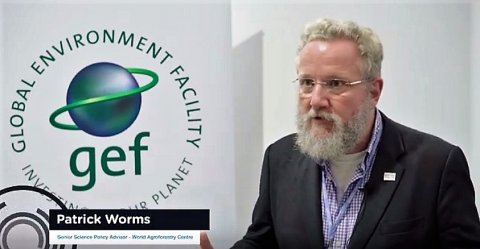by Patrick Worms
Did you know that your favourite agroforestry federation took a star turn at the climate COP in Katowice, Poland?
As EURAF President, Patrick organised an event together with GEF, the global environmental facility; CDLS, the Caux dialogue on land and security; and the World Agroforestry Centre to discuss a vexed issue: why are high-level decision-makers, whether active in the public or the private sector, so ignorant of basic ecosystemic processes, and what can we do about it?
The event, entitled “Earth systems to the rescue: how to lock in carbon without depending on blue sky technologies”, was held at the GDF pavilion on 7th December and featured a prominent roster of speakers. In addition to Patrick, there was Dr Martin Frick, who is policy director at the UNFCCC, the United Nations framework Convention on climate change and thus one of its three leaders; Dr Peter Akong Minang, who leads the tree crops theme at the world agroforestry centre; and Carl Pendragon, the CEO of a company called Skymining.
All speakers focussed their interventions on the following stark message: in its recent report, the IPCC concludes that limiting global temperature increases to 1.5°C will almost certainly require the use of technologies to draw carbon away from the atmosphere and lock it into or under the ground. One such technology, known as BECCS, gives great cause for concern. No commercial scale carbon capture and storage projects have yet been launched, despite much public support. A reductionist approach risks destroying valuable ecosystems to establish plantations of fast-growing trees for use as biofuels. Most current BECCS calculations also fail to take soil carbon dynamics into account: transforming peatlands into tree plantations, for example, can unleash a pulse of carbon much larger than the trees would sequestrate. Thus BECCS risks being a remedy that is worse than the disease.
Regenerating natural forests, by contrast, stores carbon both into trees and into the forest floor. Regenerating natural grasslands also produces food through ruminant meat and milk and, pace received wisdom, can be carbon negative once the full processes of grasslands ecology are taken into account. Turning monocrop farming into agroforestry systems increases both productivity and biodiversity while locking up yet more carbon into the soil. All these have the potential to lock gigatons of carbon into the world’s agricultural soils every year, and do not depend on complicated, expensive and untried technologies.
The fact that these processes are largely unrecognised illustrates a wider problem, which is a widespread ignorance of the basic mechanisms of how the earth system function by decision makers.
Greater ecological literacy can be the source of solutions that are not merely effective, but also highly profitable!












